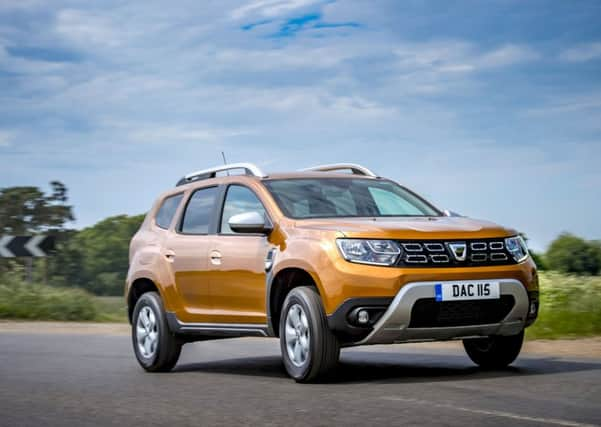Review: Dacia Duster


The best seller is the Duster SUV, available with front wheel drive or 4x4 traction, on sale here since 2012. A group of Scottish writers were given early access to the newcomer and obliged by making it “Scottish” car of the year. Top Gear voted it “bargain of the year”. Renault engines and transmissions added credibility. The prices for this family hold-all started at £8,995 – without a radio.
The second generation arrived this year after a big investment at the Pitesti factory. More than half of the Duster components are shared with other Dacia and Renault models, which keeps costs down. It looks much the same but, says the company, every exterior panel is new. Options now include automatic headlamps, keyless entry, a blind spot alert and surround-view camera. The cabin fittings and displays are new, too, to bring more seating comfort, lower noise, more visual and tactile refinement and quicker power steering.
Advertisement
Hide AdAdvertisement
Hide AdEngine choices are a non-turbo 1.6 litre 115hp petrol rated at 43.5mpg and 149g. The 4x4 version with a shorter first gear is a bit thirstier and dirtier. The 1.5 turbo diesel also delivers 115hp but a higher torque of 192 lb ft. It is rated at 64.2mpg and 115g. It is not offered with 4x4 drive. The petrol engine uses a five-speed manual gearbox, six on the 4x4, and the diesel also gets six gears.
The core specification has improved over the years but you can still get a Duster for a fiver under £10,000 – without the distraction of a radio or a diesel option. The other grades offer both engines and 4x4. Essential model, from £11,595 does bring a digital radio, air con and Bluetooth option, on 16 inch steel rims. The Comfort, from £13,195, runs on alloys, has a rear camera and sensors, power windows and mirrors, nicer upholstery, very accurate navigation and trip computer. Moving to the Prestige (£14,395) adds glitzy 17-inch wheels, the multi-view camera, smarter seating, keyless entry, climate control and a blind spot warning. All these prices are for the petrol engine. Add £2,000 for the 4x4 or diesel models.
Tested here is the front-drive petrol Comfort model with the dominant “desert orange” metallic paint a £495 option – making your Duster easier to spot among other cars. The satin chrome roof rails also help, unless your car is masked by taller SUVs. Western Europe navigation added £90 and a space-saver spare is £150. Stop-start ignition and driving economy tuition are now included.
The appearance is glossy-fronted, ebullient even in its orange skin. Changes at the rear are dominated by the new light clusters. The driving area has five face-level air outlets, a shelf over the glovebox (non-locking) and more storage spaces than in the old model. A single USB socket is above the information screen – meaning the wire has to hang down over the screen or be taken sideways to that shelf.
Another compromise is the pace from this petrol engine. The lower gears need thrashing to get it moving and the in-gear acceleration is weak. The eight-inch ground clearance, so good off-road, allows it to lean on bends. Consequently I drifted into slower driving, being peeped in town and on roundabouts.
My 50-mile typical mixed route, from city to motorway to rural, returned 42.4mpg according to the computer. It said I had covered 13.6 miles without using fuel. At this stage I didn’t know I was being analysed – just three stars from a best of five for economical acceleration, a pitiful one star for gears but a giddy four stars for anticipation (thanks to the remnants of my RoSPA training). Final score: 60/100. A subsequent motorway drive gave me 71/100 – with four stars for acceleration, two for gear choice and four for anticipation. The MPG was the same as the commute and both almost matched Dacia’s official 43.5mpg.
The ride quality is lumpy, with evident roar from the Continentals getting through the latest sound insulation.
Verdict: Roomy, cheaper than most, imposing looks. Hardly any fun to drive as tested but practical.